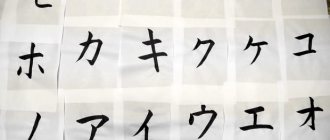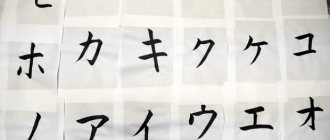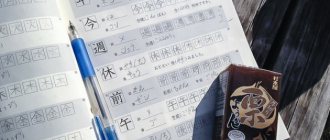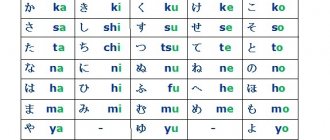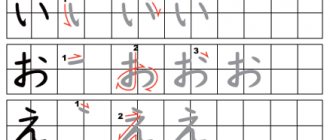Russian-Japanese phrasebook: how to explain yourself in an unfamiliar country. Popular phrases and expressions for travelers.
- New Year tours
around the world - Last minute tours
around the world
Japanese (日本語, Nihongo) is a language spoken by about 125 million people. Thanks to the many isolated islands, the country has more than a dozen dialects. They differ both in vocabulary, morphology, and pronunciation. Common dialects include Kansai-ben (関西弁), Tohoku-ben (東北弁) and Kanto-ben (関東弁), the dialect of Tokyo and the surrounding area. Speakers of different distant dialects often do not understand each other (even though every Japanese knows standard Japanese). Based on the Tokyo dialect, a “common language” (共通語 kyotsugo) was formed.
Foreigners learning Japanese should be aware of the differences between masculine and feminine forms of speech.
The convenient word “domo” in Japanese means a whole scattering of actions or emotions, for example: hello, thank you, good, long time no see, sorry, and so on. The word “i desu,” on the contrary, can lead to a difficult situation. Despite the fact that it is translated as “good,” it means “thank you, no need.” If you agree, you should say “itadakimasu”; the same word is said when sitting down at the table.
Greetings, general expressions
Good morning Ohayo: gozaimas Good evening Kombanwa Good night Oyasumi nasai Hello, how are you? Konnichiwa, o-genki des ka? Thank you, everything is fine Genki des Goodbye! Sae: nara Please excuse me Sumimasen My name is... Watashi wa... des Nice to meet you. My name is Kimura. I ask you to love and favor Hajimemashite. Watashi wa Kimura desu. Do:zo yoroshiku.Thank you Arigato I want to change money O-kane-o ryo:gae shitai de I don’t understand Wakarimasen Do you understand English?Anata wa eigo ga wakarimasu ka?I’m not very comfortable...Totto tsugo: ga waruin desu ga...Are you Mr. Tanaka? Yes. Ya TanakaAnata wa Tanaka-san desu ka? Hi. so: desu. Watashi wa Tanaka desu'Allo, this is Mr. Tanaka's apartment? Moshimoshi. Tanaka-san no o-taku desu ka? No. I'm not Japanese Iie, Watashi wa Nihonjin jya nai. I'm RussianWatashi wa Roshiajin desu DaHaiNet Iie Thank you very much Do: mo arigato: gozaimas Thank you Taihen arigato: gozaimas You're welcome Do: itashimasite No thanks O-rei niwa oyobimasen Nothing, don't worry Nandemo arimasen Thanks for the service Go-ku ro: sama deshita Thanks for the invitation Go-sho : tai arigato: gozaimas What is your name? Nan toyu: o-namae des-ka? Please tell me Totto sumimasen ga Please come in O-hairi kudasai This way, please Do: zō koutirae do: zō What is your first and last name? O-namae to myo: dzi-wa nan -to iimas-ka?Thank you for the warm welcomeGo-shinsetsu arigatoCan you help me?Onegai itashimas?I want to invite you to RussiaRussia ni go-sho: tai shitai to omoimasI want to invite you to the RestaurantResutoran ni go-sho: tai shitai to omoimasThank you for help (for cooperation) Go-kyo: ryoku arigato: gozaimas Thanks for the gift Presento arigato: gozaimas What is this? Kore wa nan des-ka? Why? Naze des-ka? Where? Doko des-ka? Who is it? Kono hito wa Donata des -ka?I'm thirstyNodo ga kawakimashitaI'm hungry (I'm hungry)O-naka ga suiteimasI'm lostMiti ni mayottaYaWatashiYou(you)AnataOnKareSheKanojoWomanJoseiManDanseiBigOokySmallChisaiHotAtsuiColdSamuiHotAtakaiColdTsumetaiGood iiIiBadWarui Let's take a photo together Isshoni shasin-o torimasho Call an interpreter Tsu: yaku-o yonde kudasai Please speak more slowly Mo: sukoshi yukkuri itte kudasaiDictionaries
YARKSI - this site is recognized as one of the best Japanese-Russian hieroglyph dictionaries. You can download it to your smartphone or computer, and you can also find the hieroglyph by simply drawing it with your finger!
Warodai - this site took Conrad's dictionary as a basis and compiled it into an electronic version. The volume of words is about 150 thousand; The dictionary can be downloaded in different formats.
Kanjiname is a convenient dictionary divided into topics and categories.
Numbers and numbers
NuldzeroOdiniti hitotsuDwani futatsuTrisan mizzuFour four yotsuFive itsutsuSixroku mutsuSevencity nanatsuEighthati yatsuNine kokonotsuTenju:toFurther in the counting, the tens of “ju” are joined by the corresponding number, showing units...
| eleven | ju:-iti |
| twelve | ju:-ni |
| thirteen | ju:-san |
| fourteen | ju:-si |
| fifteen | ju:-go |
| sixteen | ju:-roku |
…and so on. To designate tens from 20 onwards, you need, on the contrary, to add tens of “ju” to the ones...
| twenty | no-ju |
| thirty | san-ju |
| fourty | c-ju |
| eighty | Hachi-ju |
| ninety | ke-ju |
| one hundred | hyaku |
Next, the numbers are formed according to the same model: that is, units are added to 100 “hyaku”, and then tens and units.
Japanese alphabet
Forget about the usual, one-of-a-kind alphabet. Three are used in Japan. Each alphabet uses an individual writing system.
The future student should not forget about the presence of sounds.
Why do Japan use three alphabets? For comfort. To avoid confusion, the Japanese use a separate type of alphabet in a specific area:
- Hiragana is the alphabet for writing. A common letter in the Japanese alphabet can mean a combination of vowels and consonants. The letter turns into a syllable.
- Katakana is used exclusively for writing. Katakana is used to write words borrowed from European and other languages. Used to record “foreign” sounds.
- Kanji is an alphabet consisting of hieroglyphs. Most of the characters are taken from Chinese script.
Katakana, Hiragana are alphabets used in writing. Each character represents a sound, as opposed to kanji. In the latter, the spelling of a symbol can have different meanings.
Of the huge number of hieroglyphs, only two thousand characters were taken for widespread use. Kanji contains elements from katakana and hiragana.
For the good of the cause
Please show me Misete kudasai Stop for the night Tomaru I can’t believe it! Shinjirarenai Wow! Sugo-oh!! I want to buy...... about kaitai I want to eat...... about tabetai I want to go to...... or ikaitai That’s how! Look! (said very often) A soo! Soo! Sooka!Itchy!Kayuy!Can you see Mount Fuji from here?Fujisan, ga miemasu ka?Sorry. Where is the embassy? Sumimasen, taishikan wa doko desu ka? How should you eat sushi? O-sushi wa do: yatte tabemasu ka? You can’t eat on the lawn in this park Kono ko: en wa Shibafu no naka de o-bento: ga taberaramasen Do you need to take off your shoes ?Kutsu o nugun desu ka?Do you know that there was an earthquake this morning? How, really? Kesa jishin ga atta no o shitte masu ka? Eh, honto: desu ka?Apply proven techniques for memorizing hieroglyphs
There are several original tools for memorizing hieroglyphs.
Card method
Cut out the required number of cards from thick paper, indicate the symbol or hieroglyph being studied on one side, and the corresponding meaning on the other. This will help not only in learning, but also in testing your knowledge. By the way, you can purchase ready-made sets of cards.
irecommend.ru
Association method
Mnemonic memorization techniques are perfectly suited to the Japanese language. When learning kanji, it is often difficult to remember the spelling of the character and its meaning. To solve this problem, come up with your own image for each hieroglyph! For example:
- 木 (tree) really looks like a tree;
- 森 (forest) - but three trees turn into a real forest;
- 火 (fire) - a little imagination, and you are already warming your hands by the fire not far from the mountain (山).
This way you can effectively memorize several hieroglyphs at once.
s5.pikabu.ru
Train station, airport
Where can I check the train schedule? Ressha-no jikokuhyo:-wa doko desho: ka? Excuse me, where is the information desk? Sumimasen ga, annaisho-wa doko des-ka? Is there a train connection with the city from here? Koko-kara - made tetsudo:-ga tsujite imas-ka? How many hours (days) does the train go to the city? Shi-made kisha-de nan-jikan-gurai (nan-niti-gurai) des-ka? Does this train go to the city? Kono kisha-wa Si-e ikimas-ka? What time is the next train to? Yuki-no tsugi-no ressha-wa nan-ji des-ka? Excuse me, how do I get to the train station? Chotto o-tazune-shimas ga, eki-e-wa (teishaba-e-wa) to: ittara ii desho: ka? Tell me, where is the ticket office? Kippu-uriba-wa doko des-ka? How much does a ticket cost? Kippu-wa ikura des-ka? Can I return the ticket and get my money back?Kippu no haraimodoshi-o site itadakemas-ka?Is this seat free?Kono seki-wa aite imas-ka?How much is the plane ticket to?Yuki no hiko: ki no kippu- wa o-ikura des-ka?How many hours is the flight to?...made nanjikan kakarimas-ka?How many kilograms of luggage are you allowed to carry for free?Ju: ryo:-seigen-wa nan-kiro-made des-ka?Will the plane take off exactly on schedule? Hiko: ki-wa yotei-do: ri shuppatsu shimas-ka? Eki Waiting room MatiaishitsuStructure your training material
Select several proven textbooks and print out the copybooks. This will form the basis of your learning. At the same time, you can use the online simulator to test your knowledge. One of the most popular and effective is the Japanese textbook Minna no Nihongo: Basic Workbook in two parts, which is best taken immediately with a grammar commentary and additional teaching materials.
If you have a good command of English, then you can use the time-tested textbooks, workbooks and audio materials from the GENKI series that have been tested by thousands of students. From Russian publications, we can recommend the “Textbook of the Japanese language for children” in two parts by M. R. Golomidova, a well-known Russian specialist in the field of the Japanese language. The textbook will be an excellent educational aid for adults.
Passport control
Fill out the entry (exit) form Nyu: koku (shukkoku) ka: do-o kinyu: si-te kudasai Present your passport Pasupo: to-o haiken shimas Please, here is my passport Do: dzo, watashi no pasupo: to de I am a tourist Watakushi-wa Kanko: deI came on trade business Shoyo: de kimashitaCustoms inspection of luggageZeikan tenimotsu kensaPlease show your customs declarationZeikan shinkokusho-o misete kudasaiI have nothing to write down in the declarationZeikan-ni shinkoku surumono-wa arimasenThis is my luggageKore-ga watakushi -no nimotsu desNet Do you have any prohibited items? Kinseihin-wa arimasen n. eh.? This suitcase and this bag are my Watashi-no-wa kono toranku to baggu des Please open (close) your suitcase Kono toranku-o akete (shimate) kudasai These are my personal belongings Sore-wa watashi-ga jibun-de tsukau mono des Which one you currency?Do: yu: gaika-o-mochi des-ka?Here is my luggage receiptKore-ga tenimotsu uketori bango: desCafes and shops
How much does it cost? Kore wa o-ikura des ka? Can I pay with a credit card? Kureditto ka:do de haratte mo ii des ka?When will the dry cleaning be ready?Kuri:ningu wa itsu dekimasu ka?Is this watch made in Japan?Sono tokei wa nihonsei desu ka?Where can I buy?Wa doko de kaemaska?Do you have it?Arimaska?Show me this please Sore o misete kudasaiCan I try this on?Kite mite mo ii deska?Women's clothingFujin fukuMen's clothingShinshi fukuProductsSyokuryo: hinPlease tell me , where is the shopping center (neighbourhood)? Sumimasen ga, sho: tengai-wa doko des-ka? I need to buy milk and bread Is there a grocery store nearby? Pan to po: nu: -o kaitai, no des ga, kono hen-ni shokuryo: hinten-ga arimasen-ka How much do I charge for everything? Dzembu-de ikura-ni naru, but des-ka? Please give me a check Tekku-o-negai shimas I want to see the camera (video camera) Camera-o mitai, but des gaTwo coffees please Ko:hi:futatsu o-negai ShimasuNo. I'm already full. Thanks for the treat. Mo: ippai desu. Gothiso: sama deshita Is this cake delicious? No. Not very tasty Sono ke:ki wa oishi desu ka? Eee. amari oishiku nai desuOh, how delicious it was! Aah, oishikatta! Waiter! Chotto, sumimasen Menu, please Menu: kudasai What would you recommend? About susume wa nandeska? How do they eat it? Kore o do: yatte tabemaska? Japanese dishes Washoku Western dishes Yo: cheek Beef Gyu: niku Pork B utanikuChicken TorinikuFishSakanaPotatoesPote : toRiceGohanBreadPanSaladSaradaSoup: puVegetablesYasaiFruitKudamonoDessertKudamonoSaltShchioSugarSatoSoy sauceShyoyuCoffee (hot)Hotto ko: hiCoffee (iced)Aisu ko: hiBlack teaKo: chaGreen teaO: chaWine (red)AkauainWine (white)Sh Irouine Rice vodka Sake Thank you, I don't drink Do: mo arigato, watakushi-wa nomasen Please, please coffee and scrambled eggsKo:hi:to tamago no medamayaki-o-negai shimasPrograms to study
Convenient programs that can be installed on your laptop and smartphone will simplify language learning.
Wakan
This application can:
- search for hieroglyphs based on dozens of features;
- show translation and pronunciation;
- mark which hieroglyphs have already been studied;
- look up kanji in a dictionary;
- translate texts.
YARKSI
The Japanese-Russian computer dictionary contains 60,000 words, a database of hieroglyphs with Russian names and interpretations, and supports searching by multiple characteristics and by graphic image.
Anki
The program for storing flash cards is a recognized leader in its field. It has versions for all operating systems and mobile phones, including the Internet version. All you need to do is install the program on any convenient device, and then just learn.
Japanese language learning program Anki.
ZKanji
The program is a competitor to “Wakana”. They differ in that they do not contain a translator.
WWWJDIC
The program allows you to search for combinations of words in the browser and translation from the address bar.
AppLocale
If the application does not show Japanese characters, but scribbles, then you need to launch it from AppLocale. The utility allows you to run applications in a different system locale.
AGTH/Chiitrans/Chiitrans Lite
The application allows you to play novels, finding out the meanings of unfamiliar words and translating sentences.
Rikaichan
Browser module with pop-up translation of Japanese words into other languages. Has a dictionary of names.
In the city, transport
Where is the hotel? Hoteru wa doko ni arimas-ka? Where is the bank? Ginko: wa doko ni arimas-ka? How to get to the hotel? Hoteru made wa do: ittara ii des-ka? Where can I buy a telephone card? Terehon- ka: do-o doko de utteimas-ka?Where is the post office?Yu: binkyoku wa doko des-ka?What time do we meet?Nan-ji ni matiyawasesimas-ka?What kind of building is this?Kore-wa do: yu: tatemono where am I? ?Aruite ikemas-ka?Could you draw a plan for me?Totto, chizu-o kaite kudasa-imasen-ka?Will you take me to the subway station?Chikatetsu-no eki made tsure-te itte kudasaimasen-ka?From where can I call? Denwa-o sitai, no des ga, doko-kara kakerare-mas-ka? Call a taxi Takushi-o yonde kudasai I want to go to Ni ikitai des How much is a bus ticket to the city? Machi-made-no basu-no kip-pu- wa ikura des-ka?Where is the taxi stand?Takushi:-no noriba-wa doko des-ka?I’m in the centerTyu: shingai-made Please take me to this address Kono ju: sho-made, kudasaiHow much from me?Ikura des-kaThis bus can you get to the city center? Kono basu-wa, toshin-o to: rimas-ka? Please notify me when there is a stop Tei-re: zen-ni tsuitara o-shiete kudasai Stop Tomete kudasaiTips for Beginners
Mastering the language you are learning is long and difficult; the main thing is to make the lesson interesting, without compromising your knowledge. It is important to take into account a number of tips.
- They practice every day, without skipping a day. A language that has hieroglyphs in writing is memorized quickly, the main thing is not to take a break between lessons. Diversify your lessons - write in the morning, pronounce hieroglyphs, in the afternoon - make it a habit to watch films, read newspapers with a fan.
- All methods are good. We download applications, educational programs, dictionaries and movies onto our smartphone. It is enough to allocate 5-10 minutes in the subway for such training and the result will soon be visible.
- The main thing in the learning process is regularity. If you want to quickly memorize hieroglyphs, download applications with flash cards. Afterwards, look through cards with hieroglyphs according to the degree of memorability, and the program will determine the order and frequency of reproduction on a laptop monitor or phone screen.
- Learn the given words, preferably not one at a time, separately - in the formed composition of even a short expression or sentence. If you make a specific sentence with a word, short or long, it will be much easier to remember and learn in a given context.
- Communicate with a living native speaker of the language itself, even if not in person, at least via Skype or other messenger, with sound and video. It is better to live for some time in the country of the language you are learning, China.
The main thing to remember is that two components are important for learning and memorizing a language. Discipline and motivation are guaranteed mastery of the language, and choosing a method is selected individually.
In a hotel
What is the name of this hotel? Sore-wa nan toyu: hoteru des-ka? Do you have any rooms available? Aita heya-ga arimas-ka I need a room for one Hitorbeya-ga hoshii, no desga How much does a room cost per night? Kono hoteru no heyadai -wa o-ikura des-ka? Could you give us two single rooms? Singuru hutahei o-negai dekinai desho: ka? How much is a double room? Futaribey-wa ikura des-ka? I need a room with a bathtub Basutsuki no heya -ga hoshii, no des ga On what floor is our room? Watashitachi no heya-wa nangai des-ka? This room suits me Kono heya-de kekko: des Isn’t there a better (cheaper) room? Motto her (yasui) heya-wa arimasyon -ka? I would like to pay for the room tonight Watashi-wa komban-no uchi-ni shiharai-o sumasetai, but des ga Tomorrow early in the morning I will leave Asu-wa hayaku tachimas I handed over the key to the maid Ki: -wa ru: mu-me: do-ni watashimashita Receptionist/administrator Furonto Room/number Heya/kyakushitsu Bill/tip Kanjo/tippu Keys:, kagiWhat is Katakana
The order of each word in the Japanese language in the construction of a sentence is simple, even for a beginning student it is difficult to learn. You need to remember - the predicate comes at the end of each completed sentence, the definition - immediately before the defined itself. It is often omitted in the structure of a sentence if the context itself makes it clear what exactly, what object, or person is being discussed. These foundations will allow you to correctly construct a sentence in the future and speak like a real resident of the Middle Kingdom.




